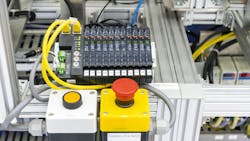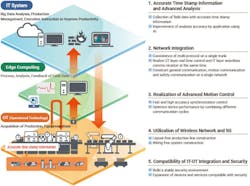Ethernet with TSN: Hardware for Protocol Support
What you’ll learn:
- Easy network integration of new protocols with time sensitive networking (TSN).
- Simplifying device development for high network bandwidth protocols.
- How to work with partners to seamlessly integrate TSN.
One of the greatest challenges a device vendor faces is the support of the many industrial networks that are available in the market. While device vendors may be experts in their domain—vision systems, LiDAR, physical measurements, etc.—they can’t be experts in every protocol supported by automation equipment. Hence, the need for a communications partner company that manages protocol support for you. They offer canned solutions for protocol support, and especially leading-edge protocols such as CC-Link IE time-sensitive networking (TSN), the highest-performance solution for motion control.
Devices come in many levels of complexity and cost. They may be simple I/O or more complicated, such as PLCs, CNCs, or robot controls. For this reason, protocol partners need to offer a range of connectivity options, from semiconductor solutions to complete communication modules (Fig. 1). Communications technology may offer support for a single protocol at a time or bundles of protocols, even end-user selected support at the time of commissioning.
Ethernet and Time-Sensitive Networking
When discussing protocols, we’ve typically been limited to the selection of one protocol for use in an application. Now that Ethernet has become the backbone for most protocols, its requirement has lessened and protocols can coexist. However, a class of application—motion control—still has communication determinism requirements that typically preclude coexistence with other protocols.
The ability to have all Ethernet protocols coexist and guarantee timing determinism was the purpose for an Ethernet standard improvement created back in 2016. That improvement delivered features for clock synchronization, traffic pre-emption, and traffic shaping to the Ethernet Specification, enabling the combination of high-priority traffic combined with other general-purpose traffic on one network.
Time-sensitive networking is the name given to the Ethernet Enhancements of 2016. With this new Ethernet specification, industrial automation protocols were able to adopt the enhanced functionality and use the features to deliver both high performance and deterministic communications capability.
Devices on a TSN-enhanced network utilize clock synchronization. They know when to send a message, and their message can be set to a higher priority than other traffic. Features also exist to shape traffic, reducing large packets (breaking them up) to make sure high-priority traffic can be interspersed for delivery. New Ethernet switches are available to segment and manage TSN traffic.
How TSN Can Benefit Users
The benefit to an end-user is that TSN products enable simplified machine architectures, allowing for a single communications backbone in the machine that can combine and manage all Ethernet traffic. In the past, deterministic traffic typically needed an isolated pathway for communications. But configuration remains simple, as the end-user is simply selecting and integrating products already capable of TSN communications. It’s a simple configuration task, not a development task.
For device manufacturers, though, the challenge is greater, as Ethernet TSN features typically require new silicon hardware for support. This will trigger a hardware revision, not just a firmware update. Leveraging a third party for communications support can greatly ease the burden of development and certification.
Equipment vendors that have deterministic communication requirements should consider the adoption of Ethernet with TSN, to enable a competitive advantage over those without that capability. Mitsubishi Electric is currently the leading vendor with Ethernet TSN support. Equipment and device vendors should consider not only Ethernet TSN, but also the leading protocol that leverages it: CC-Link IE TSN. Supporting this protocol will enable integration into the Mitsubishi Electric ecosystem of customers and OEMs, and it will allow for new and competitive architectures based on a single communications backbone.
Ethernet with TSN is intended for “Islands of Automation,” either use in a machine or along a production line. Utilizing Ethernet TSN switches will enable general-purpose communications beyond the island for informational or supervisory communications. And these communications can certainly be industrial IoT (IIoT)-related.
The ability to support all communications traffic on a single Ethernet backbone means that all devices are accessible over Ethernet. Devices involved in deterministic communications can also support standard informational communications for use outside of control.
For example, CC-Link IE TSN-based devices also offer support for Simple Network Management Protocol (SNMP) communications. Hence, the design of equipment with new Ethernet TSN architectures will naturally lead to solutions with more data, and thus will support analytics for improved performance, quality, or troubleshooting. This leads to support of the ideas of Industry 4.0, Smart Manufacturing, and Digital Transformation.
Communication networks like Ethernet or Ethernet with TSN will enable greater access to data. More data, combined with analytics, will lead to greater insights, and our new access to AI engines will only accelerate that trend.
Introducing CC-Link IE TSN
CC-Link IE TSN, the CC Link Partner Association (CLPA)’s latest open industrial Ethernet technology, combines time-sensitive networking (TSN) and gigabit bandwidth to support challenging Industry 4.0 applications (Fig. 2). To assure market success, the CLPA is announcing a broad spectrum of different device development options from a range of respected industry players who are also CLPA partners.
These companies are already providing industry-leading platforms that have found wide acceptance in the market. Hence, they’re also well-equipped to offer industry-standard development options to automation vendors who wish to add CC-Link IE TSN connectivity to their products.
Currently, the lineup of partners planning to offer this support includes Hilscher, HMS, MESCO, Mitsubishi Electric, Port, Renesas, and SILA Embedded Solutions. Discussions are ongoing to add further well-known development partners to this list. The idea is to make sure that regardless of what platform vendor a device maker may be using in their products, the CLPA will be able to offer a solution that fits with their existing design methodology.
Having a wide range of partners is only part of the puzzle. An equally wide range of development options is also essential. To address this, the CLPA is making sure that no matter what kind of design approach a device vendor has in mind, there will be a CC-Link IE TSN development solution that fits.
To this end, devices can be developed using 100-Mbit or gigabit Ethernet physical layers. This is complemented by hardware- or software-stack-based designs. The final piece of the puzzle consists of being able to take these options and use them to develop master or slave devices, meaning that all possible approaches are covered.
About the Author
Thomas J. Burke
Global Strategic Advisor, CC Link Partner Association
Thomas J. Burke is Global Strategic Advisor for the CC Link Partner Association (CLPA), whose aim is to collaborate on industrial network connectivity worldwide.
In addition, Tom serves as Global Director of Industry Standards for Mitsubishi Electric to lead the strategic development and adoption of networking standards, including the adoption of Mitsubishi Electric’s open networks solutions. Tom also is the Director of Strategic Marketing for ICONICS, providing leadership to increase market share of ICONICS’ leading-edge product portfolio.
Tom’s background includes being the former OPC Foundation President & Executive Director, and he pioneered the OPC Unified Architecture (OPC UA) as the foundation of information integration and interoperability.
He has a Bachelor’s degree in theoretical mathematics from John Carroll University (Cleveland, Ohio), and a Master’s degree in computer engineering from the University of Dayton (Dayton, Ohio).


